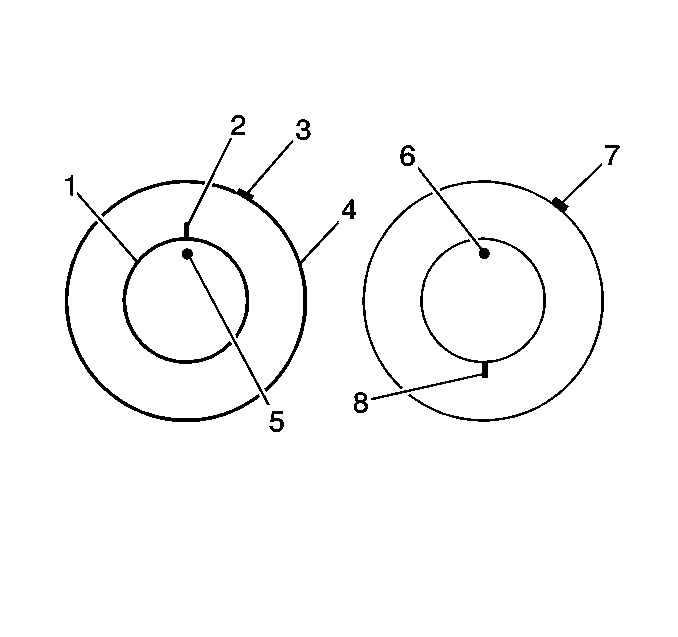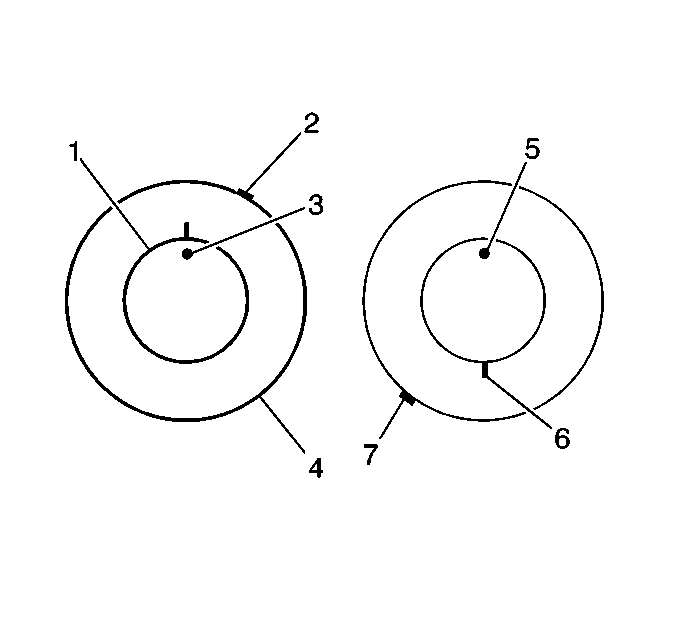If the tire and wheel assemblies exhibit an excessive amount of runout, mark the high and low spot on the tire and the wheel. The next step is to determine if the runout problem exists in the tire, wheel, or a combination of both, then to correct the condition. The procedure used to accomplish this is called match-mounting or vectoring.
- Remove the tire/wheel assembly from the vehicle. Refer to Wheel Removal in Tires and Wheels.
- Place a mark on the tire sidewall (2) at the location of the valve stem (5). This mark will be referred as the 12 o'clock position. The location of the high spot (3) will always be referred to in relation to its clock position on the wheel (1).
- Mount the tire/wheel on a tire machine and break down the bead. Do NOT dismount the tire from the wheel at this time.
- Rotate the tire 180 degrees on the rim so that the valve reference mark (6) is now at the 6 o'clock position in relation to the valve stem (5). Re-inflate the tire and make sure the bead is seated properly. You may lubricate the bead to easily rotate the tire on the wheel.
- Mount the tire/wheel on the tire balancer. Re-measure the runout. Mark the new location of the runout high point on the tire.
- If the runout is now within tolerance, rebalance the tire and wheel assembly. Refer to Tire and Wheel Balancing .
- If the clock position of the high spot is 180 degrees from the original high spot, the TIRE is the major contributor of the runout problem. Replace the tire. Refer to Tire Mounting and Dismounting in Tires and Wheels.
- If the clock location of the high spot remains at or near the clock location of the original high spot, the WHEEL is the major contributor of the runout problem. Measure the wheel for excessive runout, and replace the wheel if necessary. Refer to Tire Mounting and Dismounting in Tires and Wheels.
- If the high spot is between the two extremes, then both the tire and the wheel are contributing to the runout. Rotate the tire 90 degrees clockwise and counterclockwise from the high spot, measuring the runout after each rotation.
- Once the runout is within tolerance, rebalance the tire and wheel assembly. Refer to Tire and Wheel Balancing .


Important: Always re-measure the tire/wheel assembly runout after replacing a tire. Make sure that the runout is within tolerance BEFORE continuing. In most cases, the first 180 degree rotation of the tire will correct the runout problem or indicate which component to replace.
Important: Always measure the runout of new wheels when replacing old wheels. Do NOT assume that a new wheel is automatically a known good component.
